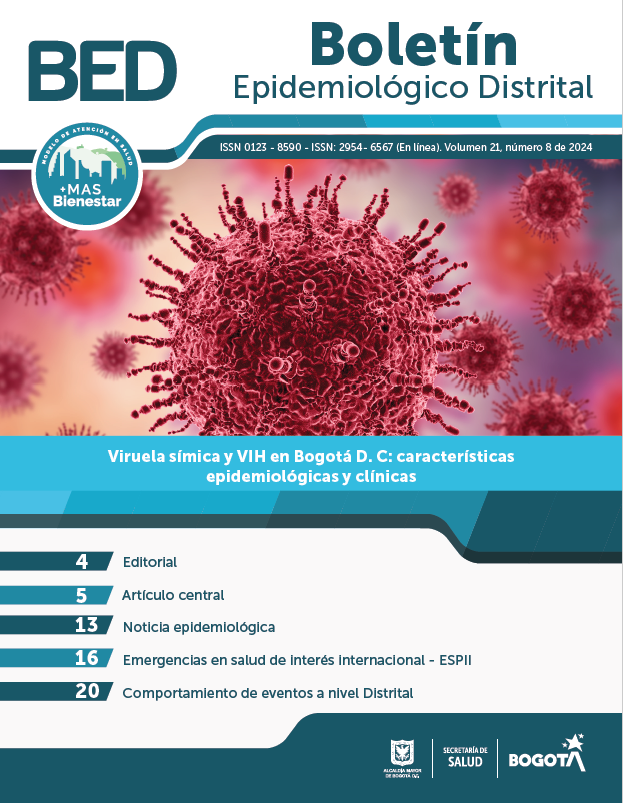Monkeypox and HIV in Bogotá D.C.: epidemiological and clinical characteristics
DOI:
https://doi.org/10.56085/bed.325Keywords:
interaction, comorbidity, causality, immunodeficiency, new and emerging, coinfectionAbstract
Monkeypox is a disease caused by the monkeypox virus of the genus Orthopoxvirus, family Poxviridae. In May and June 2022, a significant outbreak occurred and spread rapidly, affecting 44 non-endemic countries, including Colombia. In July that year, the World Health Organization (WHO) declared it a multinational epidemic. Globally, 99% of the reported cases were men who have sex with men (MSM) living with human immunodeficiency virus (HIV).
This study used an observational, analytical and retrospective methodology. The data analysis included all persons who met the operational case definition for monkeypox and whose infection was confirmed by polymerase chain reaction (PCR). In this way, the objective was set to analyze the epidemiological and clinical characteristics of the cases reported with monkeypox in Bogotá D. C. between May 2022 and February 2023. In addition, it sought to describe the disease’s behavior in the population of the capital district, as well as the characteristics of HIV coinfection, since the latter increases the risk of contracting monkeypox. Finally, the results show that 1,973 cases of monkeypox were confirmed by PCR in Bogota and most of those affected (98%) were men, with an average age of 39 years. 61.2% had HIV/AIDS. All cases experienced skin rashes, while hospitalization rate was low (3.8) and no deaths were recorded. Although a significant association was observed between HIV and monkeypox, this study does not establish a causal relationship between the two diseases.
Downloads
References
Alakunle E, Moens U, Nchinda G, Okeke M I. Monkeypox virus in Nigeria: infection biology, epidemiology, and evolution. Viruses 2020;12. Doi: 10.3390/v12111257 https://doi.org/10.3390/v12111257
Organización mundial de la salud. Monkeypox outbreak toolbox. [Internet]. Mayo de 2022. Disponible en: https://cdn.who.int/media/docs/default-source/outbreak-toolkit/clean_monkey-pox-data-collection-toolbox_23may2022.pdf?sfvrsn=502d2ef3_1&download=true
Ministerio de salud y protección social. Panorama de la Viruela Símica en Colombia y el mundo. [Internet]. Boletín de prensa No. 525 de 2022 [01 de noviembre de 2022]. Disponible en: https://www.minsalud.gov.co/Paginas/Panorama-de-la-viruela-simica-en-Colombia-y-el-mundo.aspx#:~:text=Corte%3A%20octubre%2026%20de%202022.&text=Con%20corte%20al%2024%20de,casos%20por%20cada%20100.000%20habitantes.
Organización mundial de la salud. [Internet].Viruela Símica (mpox). [16 de octubre de 2024].Centro de prensa - Preguntas y respuestas. Disponible en: https://www.who.int/es/newsroom/questions-and-answers/item/monkeypox?
Organización mundial de la salud. [Internet].Viruela Símica (mpox). [26 de agosto de 2024]Centro de prensa - Notas descriptivas - Datos y Cifras. Disponible en: https://www.who.int/es/news-room/fact-sheets/detail/monkeypox
Centers for Disease Control and Prevention. [Internet]. Signs and symptoms of Mpox. 12 de septiembre de 2024. Disponible en: https://www.cdc.gov/mpox/signs-symptoms/index.html.
Thornhill JP, Barkati S., Walmsley S., et al. MonkeypoxVirus Infection in Humans across 16 Countries - April-June 2022. [Internet]. N Engl J Med. 2022; 387: 679-691. Doi:10.1056/NEJMoa2207323 Epub 2022 Jul 21.PMID: 35866746. https://doi.org/10.1056/NEJMoa2207323
Cimerman S, Chebabo A, Cunha C, Barbosa A, Rodriguez-Morales A. Human monkeypox preparedness in Latin America - Are we ready for the next viral zoonotic disease outbreak after COVID-19. [Internet]. Braz J Infect Dis.May-Jun 2022; 26 (3):102372. Doi: https://doi.org/10.1016/j.bjid.2022.102372
Álvarez-Moreno C, Alzate-Ángel J, De La Hoz-Siegler I, Bareño A, Mantilla M, Sussman O, et al. [Internet]. Clinical and epidemiological characteristics of mpox: A descriptive cases series in Colombia. Travel Med InfectDis. [mayo-junio de 2023]. 53, 102594. Disponible en: https://doi.org/10.1016/j.tmaid.2023.102594
Instituto Nacional de Salud de Colombia [Internet].Enfermedades emergentes. Noticias.[Consultado el 27 de noviembre de 2023]. Disponible en: https://www.ins.gov.co/Noticias/Paginas/Enfermedades-emergentes.aspx
Observatorio de Salud de Bogotá - SaluData[Internet]. Datos de salud - Enfermedades transmisibles. Secretaría Distrital de Salud. Disponible en: https://saludata.saludcapitalgov.co/osb/index.php/datos-de-salud/enfermedades-trasmisibles/viruelasimica
Maguiña C, Espinal M. Viruela del mono una nueva enfermedad emergente mundial. [Internet].AMP. Colegio Médico del Perú. Lima.[2022]; 39(3): 223-6. Disponible en: https://doi.org/10.35663/amp.2022.393.2470
Mitjà O, Alemany A, Marks M, Lezama J, Rodríguez-Aldana J, et al. Mpox in people with advanced HIV infection: a global case series.[Internet]. Lancet. [2023]; 401(10380):939-949. Doi:10.1016/S0140-6736(23)00273-8 https://doi.org/10.1016/S0140-6736(23)00273-8
Buendía-Flores NN, Villena-Pacheco AE, Araujo-Castillo R. Viruela del mono (MPOX) en paciente varón heterosexual VIH negativo. AMP.[Internet]. 2022 octubre; 39(4). Disponible en: https://doi.org/10.35663/amp.2022.394.2517
Catalá A, Clavo-Escribano P, Riera-Monroig J, Martín-Ezquerra G, Fernandez-Gonzalez P, Revelles-Peñas L, et al. Monkeypox outbreak in Spain: clinical and epidemiological findingsin a prospective cross-sectional studyof 185 cases. Br J Dermatol. [Internet]. 2022 noviembre; 187(5): 765- 772. Epub 2022 Aug 20. Doi: 10.1111/bjd.21790 https://doi.org/10.1111/bjd.21790
Organización Mundial de la Salud - Organización Panamericana de la Salud [Internet].Actualización Epidemiológica sobre viruela símica - 9 de julio de 2022. Documentos. 2022. Disponible en: https://www.paho.org/es/documentos/actualizacion-epidemiologica-sobre-viruela-simica-9-julio-2022
Rodriguez-Morales A, Barbosa-Quintero Z, y Villamil-Gomez W. ¿Es posible que la viruela del mono pueda comportarse como una infección oportunista en personas viviendo con VIH?. Rev chil. infectol. [Internet]. 2022 junio; 39(3): 233-237. Disponible en: https://dx.doi.org/10.4067/s0716-10182022000200233
Cabrera-Gaytán DA, Alfaro-Martínez LA. Viruela símica: la otra pandemia, el otro reto. Rev Med Inst Mex Seguro Soc. 2023 marzo-abril; 61(3): 130-132. Disponible en: https://pmc.ncbi.nlm.nih.gov/articles/PMC10396006/
Patel A, Bilinska J, Tam JCH, Da Silva Fontoura D, Mason CY, Daunt A, et al. Clinical features and novel presentations of human monkeypox in a central London centre during the 2022 outbreak: descriptive case series. BMJ.[Internet]. 2022 julio. 28;378. Disponible endoi: 10.1136/bmj-2022-072410 https://doi.org/10.1136/bmj-2022-072410
Rodriguez-Morales AJ y Lopardo G. Viruela del mono: ¿otra infección de transmisión sexual?. Pathogens. [Internet]. 2022.11(7);713. Disponible en: https://doi.org/10.3390/pathogens11070713
Downloads
Published
Issue
Section
License
Copyright (c) 2025 Boletín Epidemiológico Distrital - BED

This work is licensed under a Creative Commons Attribution 4.0 International License.





